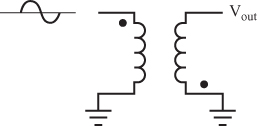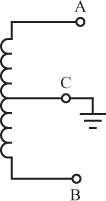These questions test your understanding of the material in this chapter. Use a separate sheet of paper for your diagrams or calculations. Compare your answers with the answers provided following the test.
1. How is a transformer constructed? _____
2. What type of signal is used as an input to a transformer? _____
3. If a sine wave is fed into a transformer shown in
Figure 10.13, what does the output waveform look like? _____
4. What is meant by the term turns ratio? _____
5. If Vin = 1 Vpp and TR = 2, what is the output voltage?
Vout _____
6. Vin = 10 Vpp and Vout = 7 Vpp, what is the turns ratio?
TR = _____
7. In the center-tapped secondary winding shown in
Figure 10.14, the voltage between points A and B may be expressed as V
A-B = 28 V
pp. What is the voltage between C and A? _____
8. In the center-tapped secondary winding shown in
Figure 10.14, the voltage between points B and C is V
B-C = = V
rms. What is the peak-to-peak voltage between A and B? _____
9. If Iin = 0.5 Arms and Iout = 2.0 Arms, what is the turns ratio? _____
10. Is the transformer in problem 9 a step-up or a step-down transformer? _____
11. If ZL = 600 ohms and ZG = 6 kΩ, find the turns ratio.
TR = _____
12. If ZL = 1 kΩ and the turns ratio is 10:1, what is the ...



